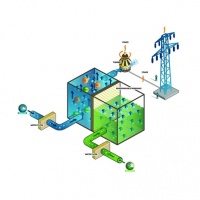
Anything that sounds too good to be true generally is, and, of course, there are drawbacks. Notably, the membranes that power this process have always been far too expensive to make commercial-scale power plants a practical proposition. Torleif Holt and Thor Thorsen, working for Norwegian research organisation SINTEF, began looking into this problem during the 1980s and became involved with Statkraft in 1997, aiming to develop lower-cost membranes based on electrically modified polyethylene. Funding from the European Union opened up in 2001 and finally – with a contribution from NASA (see panel) – put the technology into the realms of possibility.
The Statkraft plant uses a polyimide membrane capable of generating a watt per square metre of membrane, which requires a flow of 10 litres of water per second flowing through the membrane at a pressure of 10bar. The capacity of the plant is tiny: just 4kW. Yet, according to Statkraft, the potential for osmotic power is huge. The company claims that 1,600-1,700TWh of electricity could be generated globally each year. ’In Norway alone, we will be able to generate 12TWh per year, equivalent to 10 per cent of our total power consumption,’ it said.
These figures might seem fanciful, until you consider what historically happens where big rivers meet the sea: people tend to build ports and large cities grow up around them. Estuaries and river mouths are very often the site of major industrial and urban development, creating demand for power in the very place that osmotic power could provide a supply. ’A power plant the size of a football stadium could supply 15,000 households with electricity,’ said Statkraft, adding that such stations could be built underneath parks or municipal buildings, reducing their visual impact.
The cost of the membranes is, although reduced, still significant, especially if the process is to be scaled up; the pilot plant has 2,000m2 of membrane and a full-scale 25MW plant would need five million square metres, according to Stein Eric Skillhagen, Statkraft’s head of osmotic power.
Statkraft is continuing to develop the technology. ’Only once membranes with a particular efficiency have been developed will osmotic power become a competitive source of renewable energy,’ said the company, which has the ambitious aim of developing a high-performance, low-cost membrane to enable commercial-scale osmotic power by 2015. Its performance target is 5W/m2 of membrane – five times the performance of the pilot plant.
To this end, Statkraft is investigating membranes and is also testing samples developed by other organisations, including cellulose-based materials and biomimetic, protein-based substances. The company recently went on a ’membrane-hunting expedition’ to the US, organising an osmotic power membrane conference in San Diego along with the American Membrane Technology Association. ’We will meet players such as General Electric, Hydranautics, Dow and Toray,’ said Skillhagen. ’It is very important to engage in a dialogue with these players and it is also important for us to demonstrate that we are at the forefront of development of osmotic power.’
So far, he added, Statkraft’s membranes are yet to exceed 3W/m2 in laboratory tests. However, the company is continuing trials, with membrane manufacturers looking at a potential new source of high demand for their products.
There is a pleasing historical circularity to these events. Back in 18th-century Paris, experiments with pigs’ bladders and wine were something of a sideline for Nollet. He was best known, and is best remembered, as a pioneer in the research of electricity. He is especially known for discovering how an electric shock could travel along a line of people holding hands, leading to the understanding of electric current. This particular shock could travel even further.
Water treatment
An FO/RO system purifies astronauts’ urine to produce clean drinking water
NASA’s interest in osmotic power stems from its need to purify water for long space missions – particularly future attempts to land humans on asteroids and, later still, on Mars.
The Membrane Laboratory at Ames Research Centre in California is looking at systems that use forward osmosis (FO), employed in PRO osmotic power generation, and reverse osmosis (RO), familiar from desalination, to purify astronauts’ urine and the condensation from their breath to generate clean drinking water, allowing a capsule to travel into space for long periods.
This FO/RO system starts with pure and salty water in a tank separated by a membrane, through which the pure water diffuses. The diluted salt water passes through an RO system to extract the water and to reconcentrate the brine. Another system, called direct contact membrane distillation, heats urine and breath condensate to form water vapour, which passes into a chamber and across a water-repelling membrane, removing non-volatile organic compounds that would foul RO membranes.
The treated water from this process is combined with the treated water from the FO/RO system and is passed through a catalytic oxidation system that removes any organics, bacteria and viruses.





Poll: Should the UK’s railways be renationalised?
I think that a network inclusive of the vehicles on it would make sense. However it remains to be seen if there is any plan for it to be for the...